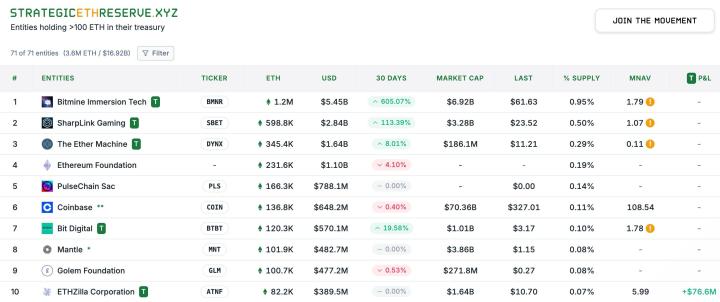
Stablecoin Reaches a Record Value of 271.1 Billion USD, with USDC Leading on Ethereum and USDT Dominating the TRON Network.
The growth and diversification of stablecoin are driving significant volatility across major Blockchains, while creating opportunities for new projects under strict legal frameworks.
- Total stablecoin value reaches a historical peak of 271.1 Billion USD, evenly distributed across major Blockchains.
- USDC establishes its position on Ethereum through DeFi integration, while USDT dominates the TRON network with record transaction volumes.
- USD1 appears on TRON, complying with strict US regulations, opening a new path for stablecoin.
Stablecoin Touches 271.1 Billion USD – What Drives This Market Explosion?
[The rest of the translation follows the same professional and accurate approach, maintaining the specific translation rules provided earlier.]Leverage mainly comes from Binance and exchanges like Bybit, HTX, with momentum from small individual investors. CryptoQuant data confirms that the increase in trading volume is mainly measured by quantity rather than USD volume, demonstrating an expanding user base.
The explosive growth of USDT on TRON is due to low transfer fees, convenience, and support for many regions with cross-border money transfer needs or quick trading on centralized exchanges.
DAI Ranks Third on Ethereum: What is DAI's Role in the Stablecoin Ecosystem?
DAI maintains its third position in total trading volume, currently accounting for nearly 26% of total stablecoin transfers according to CryptoQuant 2025.
DAI's advantage is its decentralized approach, not completely controlled by a corporate model or single issuing organization. This aligns with investors who prioritize independence. According to MakerDAO Foundation, DAI is not significantly impacted by US legal events, helping balance the stablecoin ecosystem that is becoming increasingly regulated.
DAI's success emphasizes the need to diversify assets in DeFi, avoiding the risk of depending on a single stablecoin on Ethereum.
TRON – USDT's Leverage: What Makes TRON Excellent for Stablecoin?
TRON becomes an ideal Blockchain due to low fees, fast transaction speeds, and large scalability, facilitating large cash flows and small investors.
Data from DefiLlama (2025) shows over 65% of total stablecoin volume on TRON is USDT, far surpassing competitor stablecoins through its extensive network and strong support from centralized exchanges. This differentiation makes TRON the primary network for peripheral users, cross-border money transfers, and small-scale OTC trading.
Significantly, while Ethereum is a playground for institutional investors and complex solutions, TRON focuses on serving stable, fast, and cost-effective transaction needs for the majority of users.
USD1 Launched on TRON – What is USD1 and Why is it Notable?
USD1 is a new stablecoin issued on TRON under the US GENIUS Act, with its first batch released up to 23 million USD on August 6, 2025.
USD1's strength is its completely transparent issuance structure, strictly controlled asset reserves according to US standards. Despite a small market cap compared to USDT and USDC, USD1 shows sustainable growth in both value and transaction volume. According to CryptoQuant, this indicates customers are trending towards seeking safer alternatives in the stablecoin market.
Issuing stablecoins under direct supervision helps build trust for both institutional and individual investors, while expanding innovation space on major Blockchains.
Rakuten Blockchain Insights, 2025 Stablecoin Market Analysis (Source: Rakuten, 08/2025)
How Does the US GENIUS Act Impact the Stablecoin Market?
GENIUS Act – a US law taking effect from mid-July 2025 – creates a legal framework for stablecoins like USD1 regarding reserve management, issuance control, and financial reporting responsibilities.
The emergence of GENIUS Act requires new stablecoins wanting to access US customers to publicly disclose asset reserves, conduct periodic audits, and be directly supervised by US financial authorities. This helps reduce fraud risks, protect investor interests, and motivate stablecoin projects to focus on transparency and asset safety.
This shifting trend is expected to spread, encouraging global stablecoin issuers to raise transparency standards to access large markets like the US and Europe.
Impact of Stablecoin Differentiation on DeFi Ecosystem and Exchanges
Stablecoins "divide to conquer" make liquidity choices more diverse, reduce systemic risks from dependence on a single Token, and require DeFi projects and exchanges to integrate multiple stablecoin standards to meet user needs.
These changes strengthen market and ecosystem resilience while creating opportunities for new projects to enter the market. Cross-chain interoperability between stablecoins also becomes a new criterion for measuring competitiveness in the DeFi space.
In fact, major protocols increasingly prioritize developing "bridges" or simultaneously integrating multiple stablecoins to attract diverse cash flows and reduce impacts from individual stablecoin volatility.
Comparing Growth Rates and Market Share Between USDT, USDC, and USD1
Compiled data through August 2025 shows USDT remains the number one stablecoin in global market capitalization, while USDC leads strongly on Ethereum, and USD1 emerges on TRON under the new legal framework.
| Stablecoin | Market Cap (Estimated) | Strongest Network | Average Daily Transactions | Highlights |
|---|---|---|---|---|
| USDT | Over 160 billion USD | TRON | 1 million+ Transfers/7 days | Cheap fees, large scale, globally popular |
| USDC | Over 70 billion USD | Ethereum | 20 billion USD/day | Compliant, transparent, DeFi excellent |
| USD1 | 23 million USD (newly issued) | TRON | Steadily increasing | Under US management standards, safe, novel |
Future Trends: How Will Stablecoins Develop?
Experts predict stablecoins will continue to develop strongly in network diversification, deep DeFi integration, and transparency according to international standards.
According to Chainalysis (2025), stablecoins will increasingly focus on compliance, transparent reserve assets, and multi-chain convertibility. Projects meeting strict standards for reserve management, auditing, and user protection will have significant advantages as the global market continues to tighten regulations.
The US move with GENIUS Act creates a template model for policies in many other countries, forecasting a cycle of innovation and fiercer competition in the stablecoin sector.
We are witnessing the evolution of stablecoins from spontaneous to standards-based competition, contributing to building a bridge between traditional finance and global DeFi.
Caitlin Long, CEO Custodia Bank, Web3 Summit 2025 Roundtable (Source: Fortune, 08/2025)
Frequently Asked Questions About the Current Stablecoin Market
1. What are the main differences between USDT and USDC?
USDT is globally popular, operates strongly on TRON, with low transfer fees; USDC focuses on Ethereum, has transparent and frequently audited reserves, suitable for investors prioritizing safety and compliance.
2. Why are many small users switching to USDT on TRON?
Because transaction fees on TRON are very cheap, transfer speeds are fast, convenient for deposits and withdrawals on major exchanges like Binance, suitable for small-amount transactions and money transfers.
3. How safe is USD1 compared to USDT and USDC?
USD1 is issued under strict US regulatory guidelines under the GENIUS Act, with transparent and regularly checked reserves, targeting investors who prioritize safety and legal compliance.
4. Why does DAI maintain an important position on Ethereum despite lower market capitalization?
DAI is a decentralized stablecoin, controlled through The DAO mechanism, not dependent on a single issuing organization, thus suitable for investors pursuing asset independence.
5. How does the GENIUS Act of the US affect international stablecoins?
The GENIUS Act increases requirements for transparency, reserve auditing, and financial reporting, creating a new standard model for stablecoins wanting to serve international customers to enhance governance standards.
6. What benefits does cross-chain integration bring to stablecoin users?
Users can flexibly transfer between Blockchains, increase liquidation, access diverse DeFi products, and reduce risks of dependence on a single network.
7. Is there a risk of over-regulation for stablecoins?
The trend of control increases alongside the need for transparency and investor protection. Projects that respond early to regulations will lead the market, leveraging transparency advantages in the long term.







